In this section, we look at a range of different hydraulic circuits and analyse how they work. We discuss the benefits and drawbacks of each approach including typical applications where they may be used.
Self-study lesson plans and training record download page.
Fixed displacement pump with single open center valve
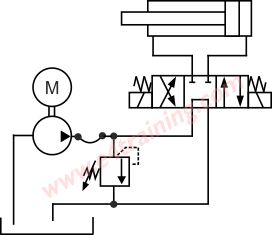
Fixed displacement pumps can provide the cheapest and most simple form of hydraulic power supply although they do have some limitations in how they can be used.
The arrangement shown has an open-centre, directional valve in the mid positions so that the pump is normally unloaded and will only see pressure when the extend or retract solenoids are operated.
This provides one of the most energy-efficient hydraulic circuits because standby losses are minimal and there are no flow control restrictions (cylinder moves at the speed of the pump flow), so the pump only sees the load pressure required.
Experiment with the Fixed Pump Experiment simulation.
Fixed displacement pump with multiple open center valves
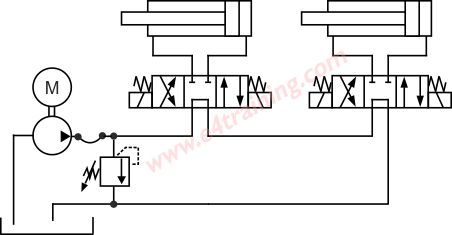
This image shows a simple, fixed displacement pump feeding two directional valves. The pump flow passes through the centre of the first valve before it reaches the second. This means that the valves run in series with each other and if the first valve is operating, then the second valve will not have the same flow available to it. More importantly, the load pressure from one section will affect the pressures acting on the next section and therefore the performance of that cylinder. However, if each valve system works independently then it still provides an efficient hydraulic system.
Other advantages of the open-centre system are that the full pump flow passes through the filters and coolers which will help to keep the fluid in good condition. Plus there is no pump case drain line required.
Fixed pump, open-centre systems are commonly used in mini-power packs.
Experiment with the Fixed Pump Open Center Valves simulation.
Fixed displacement pump with closed center circuit
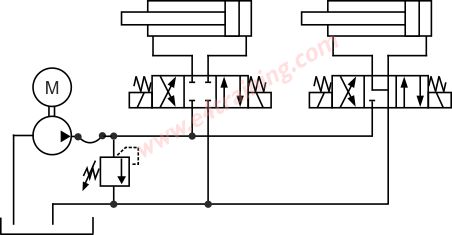
To provide independent valve operation with a fixed displacement pump then closed center valves can be used. However, under this arrangement the pump will operate against the relief valve the whole time it is running, which will not be efficient. Also, if one cylinder has less load than the other then that cylinder will always operate before the other.
Compare the input power required for both open center and closed center circuits in our simulation circuit examples.
Experiment with the Fixed Pump Closed Center Valves simulation
Fixed displacement pump with an accumulator
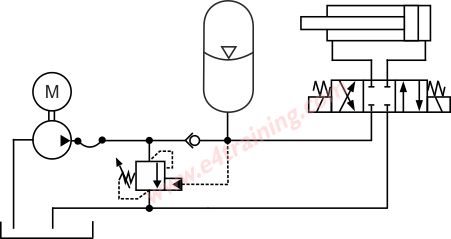
To provide a constant pressure supply and closed-centre valves, fixed displacement pumps can be used with an accumulator to balance and smooth the flow. In this circuit, an accumulator charging valve is used to switch the pump from high-pressure supply to low pressure unload bypass. Alternately a pressure switch may be used to turn the pump's electric motor on and off, based on when the accumulator needs to be recharged. Note! The accumulator safety block has not been shown.
Experiment with the Fixed Pump with and Accumulator simulation
Variable displacement pump closed-centre circuits
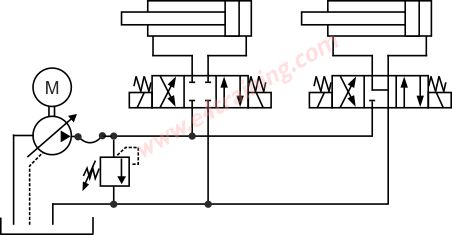
With variable displacement, pressure compensated pumps the valve centre conditions need to be closed, e.g. the pump backs off to produce only enough flow to compensate for the spool leakages while still maintaining its set pressure.
When operating each valve should perform independently of each other and their operation should be smoother as the pump will already be at maximum pressure.
Case drain flow provides an additional loss and inefficiency to the system but these flows do help keep the pump cool.
Variable displacement, closed-centre systems are commonly used in larger industrial power units.
Experiment with the operation and energy usage of both open-centre and closed-centre, fixed and variable circuit designs.
Experiment with the Variable Pump Closed Center Valves simulation.
Fixed displacement pump with load sensing valves
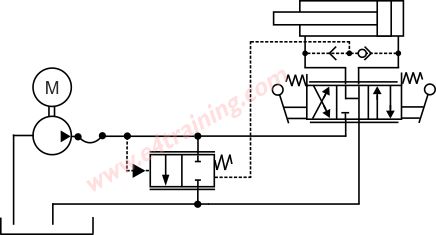
Common in US mobile equipment is the use of a fixed displacement pump with load sensing valves. In standby, the load-sensing valve switches to open-centre to unload the pump when no demand is required. The load-sense valve restricts the tank return line when flow is demanded by the actuators. The required load is fed back via the shuttle valve load sense feedback line. Note that the load sense and proportional valve are both flow control valves e.g. they restrict the flow and generate a pressure drop across them, which is used to switch the load sense valve.
Variable displacement load sensing pump circuits
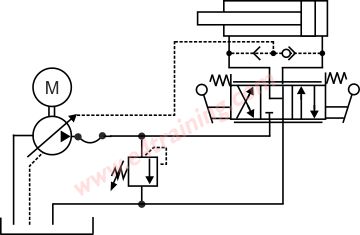
With load-sensing, variable displacement pumps the system remains at pressures, in closed centre mode, when no flow is required. When flow is demanded the pressure drop, sensed across the valve orifice restriction, is fed back onto the pump controller to demand the additional flow. There are several different types of load sensing systems with subtle differences in how they work, often due to manufacturer patents. The circuit shown is a simplified load-sensing system with the control restriction across the valve. Common variants include pre-compensation, post-compensation, and positive or negative feedback. There are more examples in our mobile design strategies section. Compensators typically use a 15-20 bar pressure loss to provide the control.
Variable displacement, closed-centre systems are commonly used in ships and European mobile equipment.